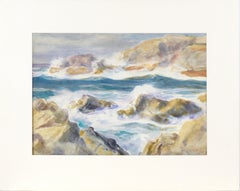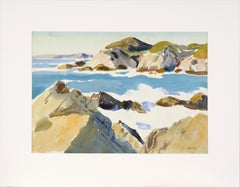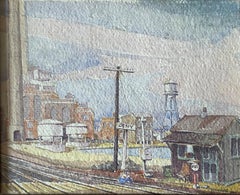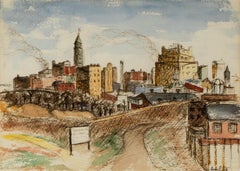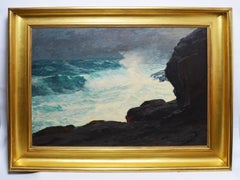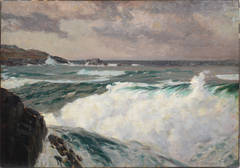Paul Dougherty Art
American, 1877-1947
Paul Dougherty was an American marine painter known for his American Impressionist paintings of the coasts of Maine and Cornwall in the years after the turn of the 20th century. His work has been described as bold and masculine. Some of his recognized work includes paintings of breakers crashing against rocky coasts and mountain landscapes. He also liked painting still life, creating prints and sculpting.
to
2
2
Overall Width
to
Overall Height
to
2
2
2
2
2
2
2
1
1
2
2
2
2
10,138
2,779
1,375
1,369
2
Artist: Paul Dougherty
Rocky California Seascape in Watercolor on Paper
By Paul Dougherty
Located in Soquel, CA
Rocky California Seascape in Watercolor on Paper
Dramatic coastal landscape by notable artist Paul Dougherty (American, 1877-1947). Waves are churning ...
Category
Early 20th Century American Impressionist Paul Dougherty Art
Materials
Paper, Watercolor
$1,480 Sale Price
20% Off
Big Sur Coast Landscape in Watercolor on Paper
By Paul Dougherty
Located in Soquel, CA
Big Sur Coast Landscape in Watercolor on Paper
Serene coastal landscape by notable artist Paul Dougherty (American, 1877-1947). The viewer looks out ov...
Category
Early 20th Century American Impressionist Paul Dougherty Art
Materials
Paper, Watercolor
$1,480 Sale Price
20% Off
Related Items
"Train Station, " Max Kuehne, Industrial City Scene, American Impressionism
By Max Kuehne
Located in New York, NY
Max Kuehne (1880 - 1968)
Train Station, circa 1910
Watercolor on paper
8 1/4 x 10 1/4 inches
Signed lower right
Provenance:
Private Collection, Illinois
Max Kuehne was born in Halle, Germany on November 7, 1880. During his adolescence the family immigrated to America and settled in Flushing, New York. As a young man, Max was active in rowing events, bicycle racing, swimming and sailing. After experimenting with various occupations, Kuehne decided to study art, which led him to William Merritt Chase's famous school in New York; he was trained by Chase himself, then by Kenneth Hayes Miller. Chase was at the peak of his career, and his portraits were especially in demand. Kuehne would have profited from Chase's invaluable lessons in technique, as well as his inspirational personality. Miller, only four years older than Kuehne, was another of the many artists to benefit from Chase's teachings. Even though Miller still would have been under the spell of Chase upon Kuehne's arrival, he was already experimenting with an aestheticism that went beyond Chase's realism and virtuosity of the brush. Later Miller developed a style dependent upon volumetric figures that recall Italian Renaissance prototypes.
Kuehne moved from Miller to Robert Henri in 1909. Rockwell Kent, who also studied under Chase, Miller, and Henri, expressed what he felt were their respective contributions: "As Chase had taught us to use our eyes, and Henri to enlist our hearts, Miller called on us to use our heads." (Rockwell Kent, It's Me O Lord: The Autobiography of Rockwell Kent. New York: Dodd, Mead and Co., 1955, p. 83). Henri prompted Kuehne to search out the unvarnished realities of urban living; a notable portion of Henri's stylistic formula was incorporated into his work.
Having received such a thorough foundation in art, Kuehne spent a year in Europe's major art museums to study techniques of the old masters. His son Richard named Ernest Lawson as one of Max Kuehne's European traveling companions. In 1911 Kuehne moved to New York where he maintained a studio and painted everyday scenes around him, using the rather Manet-like, dark palette of Henri.
A trip to Gloucester during the following summer engendered a brighter palette. In the words of Gallatin (1924, p. 60), during that summer Kuehne "executed some of his most successful pictures, paintings full of sunlight . . . revealing the fact that he was becoming a colorist of considerable distinction." Kuehne was away in England the year of the Armory Show (1913), where he worked on powerful, painterly seascapes on the rocky shores of Cornwall. Possibly inspired by Henri - who had discovered Madrid in 1900 then took classes there in 1906, 1908 and 1912 - Kuehne visited Spain in 1914; in all, he would spend three years there, maintaining a studio in Granada. He developed his own impressionism and a greater simplicity while in Spain, under the influence of the brilliant Mediterranean light. George Bellows convinced Kuehne to spend the summer of 1919 in Rockport, Maine (near Camden). The influence of Bellows was more than casual; he would have intensified Kuehne's commitment to paint life "in the raw" around him.
After another brief trip to Spain in 1920, Kuehne went to the other Rockport (Cape Ann, Massachusetts) where he was accepted as a member of the vigorous art colony, spearheaded by Aldro T. Hibbard. Rockport's picturesque ambiance fulfilled the needs of an artist-sailor: as a writer in the Gloucester Daily Times explained, "Max Kuehne came to Rockport to paint, but he stayed to sail." The 1920s was a boom decade for Cape Ann, as it was for the rest of the nation. Kuehne's studio in Rockport was formerly occupied by Jonas Lie.
Kuehne spent the summer of 1923 in Paris, where in July, André Breton started a brawl as the curtain went up on a play by his rival Tristan Tzara; the event signified the demise of the Dada movement. Kuehne could not relate to this avant-garde art but was apparently influenced by more traditional painters — the Fauves, Nabis, and painters such as Bonnard. Gallatin perceived a looser handling and more brilliant color in the pictures Kuehne brought back to the States in the fall. In 1926, Kuehne won the First Honorable Mention at the Carnegie Institute, and he re-exhibited there, for example, in 1937 (Before the Wind). Besides painting, Kuehne did sculpture, decorative screens, and furniture work with carved and gilded molding. In addition, he designed and carved his own frames, and John Taylor Adams encouraged Kuehne to execute etchings. Through his talents in all these media he was able to survive the Depression, and during the 1940s and 1950s these activities almost eclipsed his easel painting. In later years, Kuehne's landscapes and still-lifes show the influence of Cézanne and Bonnard, and his style changed radically.
Max Kuehne died in 1968. He exhibited his work at the National Academy of Design, the Art Institute of Chicago, the Carnegie Institute in Pittsburgh, the Memorial Art Gallery of the University of Rochester, and in various New York City galleries. Kuehne's works are in the following public collections: the Detroit Institute of Arts (Marine Headland), the Whitney Museum (Diamond Hill...
Category
1910s American Impressionist Paul Dougherty Art
Materials
Paper, Watercolor
$2,800 Sale Price
20% Off
H 13.5 in W 15.5 in
1950s Denver Skyline Painting – Graphite & Watercolor Colorado Cityscape Art
Located in Denver, CO
A captivating midcentury cityscape titled "Denver Skyline", this original 1950s watercolor and graphite painting offers a rare industrial-era view of lower downtown Denver, Colorado....
Category
1950s American Impressionist Paul Dougherty Art
Materials
Watercolor, Graphite
$1,950
H 17.5 in W 21.5 in D 0.75 in
Charles Partridge Adams, Colorado Landscape Gouache, 20th-Century Plein Air Art
By Charles Partridge Adams
Located in Denver, CO
This original circa 1910s plein air field study by celebrated Colorado landscape painter Charles Partridge Adams (1858–1942) beautifully captures the tranquil majesty of the Rocky Mo...
Category
1910s American Impressionist Paul Dougherty Art
Materials
Gouache
$1,880
H 13.75 in W 17.75 in D 0.75 in
Planting (Spring Plowing) - Watercolor Landscape Painting with Figures, c. 1939
By Thomas Hart Benton
Located in Palm Desert, CA
"Planting (Spring Plowing)", a vibrant watercolor and graphite on paper by Thomas Hart Benton, circa 1939-40, embodies the artist's signature Regionalist style. The work depicts a ru...
Category
Mid-20th Century American Impressionist Paul Dougherty Art
Materials
Paper, Watercolor, Graphite
Antique Impressionist Painting "Spanish Peaks" Colorado Mountain Landscape 1900
By Charles Partridge Adams
Located in Portland, OR
A very attractive American Impressionist watercolor & gouache painting, "The Spanish Peaks" Colorado mountain landscape scene, by Charles Partridge Adams (1858-1942), circa 1900.
Thi...
Category
Early 1900s American Impressionist Paul Dougherty Art
Materials
Watercolor, Gouache
$3,950
H 20 in W 25 in D 1 in
"Monhegan Island, Maine, " Edward Dufner, American Impressionism Landscape View
By Edward Dufner
Located in New York, NY
Edward Dufner (1872 - 1957)
Monhegan Island, Maine
Watercolor on paper
Sight 16 x 20 inches
Signed lower right
With a long-time career as an art teacher and painter of both 'light' and 'dark', Edward Dufner was one of the first students of the Buffalo Fine Arts Academy to earn an Albright Scholarship to study painting in New York. In Buffalo, he had exchanged odd job work for drawing lessons from architect Charles Sumner. He also earned money as an illustrator of a German-language newspaper, and in 1890 took lessons from George Bridgman at the Buffalo Fine Arts Academy.
In 1893, using his scholarship, Dufner moved to Manhattan and enrolled at the Art Students League where he studied with Henry Siddons Mowbray, figure painter and muralist. He also did illustration work for Life, Harper's and Scribner's magazines.
Five years later, in 1898, Dufner went to Paris where he studied at the Academy Julian with Jean-Paul Laurens and privately with James McNeill Whistler. Verification of this relationship, which has been debated by art scholars, comes from researcher Nancy Turk who located at the Smithsonian Institution two 1927 interviews given by Dufner. Turk wrote that Dufner "talks in detail about Whistler, about how he prepared his canvasas and about numerous pieces he painted. . . A great read, the interview puts to bed" the ongoing confusion about whether or not he studied with Whistler.
During his time in France, Dufner summered in the south at Le Pouleu with artists Richard Emil Miller...
Category
Early 20th Century American Impressionist Paul Dougherty Art
Materials
Paper, Watercolor
Mount Monadnock
By Gifford Beal
Located in Milford, NH
A fine monochromatic watercolor landscape painting of Mount Monadnock in New Hampshire by American artist Gifford Beal (1879-1956). Beal was b...
Category
Mid-20th Century American Impressionist Paul Dougherty Art
Materials
Paper, Watercolor
'Moss Beach, Monterey, California', Pacific Coastal Landscape, ASL NYC, Benezit
By Elmer Wachtel
Located in Santa Cruz, CA
An early-20th-century, landscape showing a view of the coastline at Moss Beach in Monterey County with slate-blue skies overhead and a view towards a stand of windswept Monterey Cypress with a view of the cobalt blue ocean beyond. A particularly fresh and bright example, kept until recently in a portfolio.
Monogrammed lower right, "EW", dated "X-mas 1909", signed verso, "Elmer Wachtel", and inscribed lower left, "Moss Beach, Monterey County, California".
A prominent California landscape painter of the late 19th and early 20th-century, Elmer Wachtel specialized in panoramic coastal scenes and desert and mountain landscapes using impressionist brushstrokes. His early works were tonalist in mood, and his later paintings were more decorative and light hearted.
Elmer Wachtel was an American artist who holds a high place in the early California school of Impressionism. He was born in Baltimore, Maryland on January 21, 1864 -- he received his artistic training at the Art Students' League of New York under William Merritt Chase, and the Art School in London 1901-02. While in California he resided and maintained studios in Los Angeles and Pasadena.
In 1904 Elmer Wachtel married the artist Marion Kavanaugh (1876-1954) in Chicago. Husband and wife were frequently seen painting the Southern California landscape -- they were known to have traveled by horseback over the San Marcos Pass to the Santa Inez Valley -- they traversed and painted the coastline between Gaviota and Conception Lighthouse (just north of Santa Barbara, California), the Cooper Ranch (north of Santa Barbara), Matilija Canyon and Ojai, California. Venturing south the couple made it to the San Luis Rey River (near present day Oceanside) and the Cerisa Loma Ranch (near San Diego). In 1908 they trekked to the arid deserts of Arizona and New Mexico painting...
Category
Early 1900s American Impressionist Paul Dougherty Art
Materials
Paper, Watercolor, Gouache
'Landscape', New York, Boston Art Club, London, PAFA, AWS, NAD, Benezit
Located in Santa Cruz, CA
Signed lower right, 'Rhoda Holmes Nicholls' (British-American, 1854-1948) with dedication 'To my dear friend Marietta M. Andrenes'.
Framed dimensions: 16.75 H x 1.25 D x 10.5 W inche...
Category
Early 20th Century American Impressionist Paul Dougherty Art
Materials
Paper, Watercolor
$4,500
H 12.25 in W 6.25 in D 0.13 in
Boat Scene
By Fairfield Porter
Located in Miami, FL
Watercolor on heavy paper
work is unframed
Signed by artist in pencil, lower right verso.
Property from the estate of Anne E. C. Porter, with the estate stamp, verso.
...
Category
1950s American Impressionist Paul Dougherty Art
Materials
Watercolor, Paper
Sangre de Cristo Mountains Watercolor Landscape Painting, Southern Colorado
By Alfred Wands
Located in Denver, CO
This original watercolor painting by Alfred Wands (1904-1998) captures the breathtaking beauty of the Sangre de Cristo Mountain range in Sou...
Category
20th Century American Impressionist Paul Dougherty Art
Materials
Watercolor
$3,400
H 28.25 in W 34 in D 1.25 in
Windy, Impressionist Watercolor Painting by Erik Freyman
By Erik Freyman
Located in Long Island City, NY
An Art Deco painting of a Fashionable Lady watching her sailor raise his sail by contemporary artist Erik Freyman.
Watercolor on Paper, signed
13 x 16 in. (33.02 x 40.64 cm)
Category
1990s American Impressionist Paul Dougherty Art
Materials
Watercolor
Previously Available Items
Crashing Surf by Paul Dougherty
By Paul Dougherty
Located in Buffalo, NY
Large seascape oil painting with crashing surf by Paul Dougherty (1877 - 1947). Oil on canvas, circa 1905. Signed lower right, "Paul Do...
Category
Early 1900s Impressionist Paul Dougherty Art
Materials
Canvas, Oil
Crashing Surf
By Paul Dougherty
Located in Buffalo, NY
A large oil on canvas by Paul Dougherty. Finely painted with thick impasto and great depth. Excellent condition. A couple spot touch ups. Signed low...
Category
Early 1900s American Impressionist Paul Dougherty Art
Materials
Canvas, Oil
Paul Dougherty art for sale on 1stDibs.
Find a wide variety of authentic Paul Dougherty art available for sale on 1stDibs. You can also browse by medium to find art by Paul Dougherty in paint, paper, watercolor and more. Much of the original work by this artist or collective was created during the 20th century and is mostly associated with the Impressionist style. Not every interior allows for large Paul Dougherty art, so small editions measuring 27 inches across are available. Customers who are interested in this artist might also find the work of James March Phillips, Greta Allen, and Laurence Sisson. Paul Dougherty art prices can differ depending upon medium, time period and other attributes. On 1stDibs, the price for these items starts at $1,480 and tops out at $1,480, while the average work can sell for $1,480.
